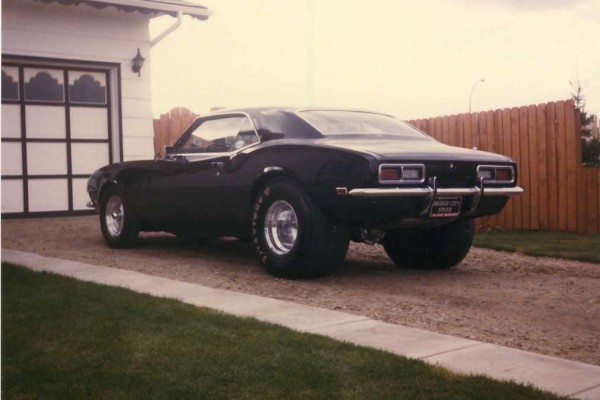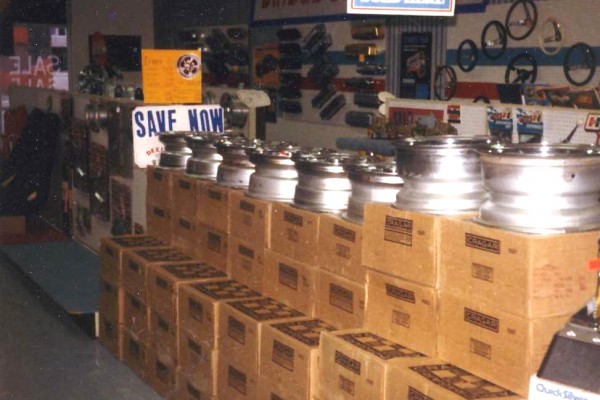Editor’s Note: Christmas often makes us feel nostalgic, so we asked one of our most-veteran contributors, Wayne Scraba, to tell us about some of his favorite experiences in hot rodding. In the post, he takes us for ride in the Wayback Machine to the days he owned a speed shop in Western Canada and shows us how cars were built in those days—and what parts went into those cars. He’ll be back at it next month with more tech stuff.
Almost four decades ago, I turned the key to open my first speed shop. (It really was on a corner, too.) We were young and times were heady: there were no distractions like video games, the Internet, cell phones, or cable. Instead, there was a passion for racing, high performance, and “how on earth” fast cars. In my neighborhood, they ranged from tri-five Chevy’s to traditional muscle cars. Those cars were cheap and readily available; if you paid $1,000 or so for a super clean, low mileage ’55, you paid a lot. Gasoline was around 39 to 53 cents a gallon.
Racing fueled a lot of passion. There was an oval track crowd in our town, but their rules were so restrictive, there was little I could sell them. Drag racing, on the other hand, was alive and well. Sportsman drag racing was huge, with plenty of bracket racing for the little guys and a lot of class racing for the more serious folks. Door cars were the order of the day and many of these were vintage muscle cars. My shop sponsored two different Super Stock cars—a 283-powered Nova and a 327-powered Chevelle. The Chevelle went on to become a multi-time NHRA National Record holder in SS/LA. That was a massive accomplishment at the time.
Unless it was a fuel or alcohol car, altereds and dragsters were few and far between. One of the local speed shops ran a nicely crafted 427 Ford-powered altered. When NHRA started their Econo Altered class, a few more cars popped up. There were some real oddities at the strip too. One guy ran dual Wankel engines in his Mazda. The shriek from the open exhaust was impressive. Even more impressive was a “back east” 426 Race Hemi-powered International Harvester Scout that occasionally ventured west to our track. It was an absolute beast.
It wasn’t uncommon for customers to build a 12:1 and higher compression ratio engine for the street. A “big squeeze” combination was popular, and they sounded great at idle—they made such a nice “pop.” Those honking compression ratios meant customers mixed their own fuel. Sunoco “high test” was an Eastern thing and unavailable. Aside from race fuel, the best you could do was to add various octane booster concoctions. I sold Moroso octane booster as well as Octane 104+. Some guys were actually mixing 100-130 aviation gas with pump gas laced with a lot of Toluene. I even bought a gas hydrometer setup so I could test the specific gravity of mixed fuel. Experience showed us that the Toluene mix eats rubber fuel lines, kills fuel pump seals and tends to create more engine wear. Pure Toluene isn’t exactly good for you to inhale either.
The small block Chevy was still The King, with the big block Chevy not far behind. Then came Mopars with “everything else” bringing up the rear. Customers buying speed parts regularly studied car magazines and pretty much knew exactly what they wanted. Once, a speed equipment warehouse back east offered us a great buy if we bought 12 or more 454 LS7 big block factory crate motors (the GM part number was 3965774). I bought a bunch of them at once and stacked them up in the back room of the shop. Looking at that stack of crate motors (and the big money dollars they represented) kept me up nights. I did manage to sell them all and pacify my ulcer.
Competing shops tended to specialize in particular product lines. For example, my shop primarily sold and serviced Holley carburetors (double pumpers and 3310’s were the big movers), while one on the other side of town specialized in Carters. They sold Crane cams, but my shop sold Cam Dynamics and later General Kinetics, Competition Cams, and Ultradyne cams.
Sun and Stewart Warner tachs and gauges still ruled the roost. I added Auto Meter tachs and gauges to the mix, but it took a while for them to catch on. Headers and exhaust were big part of the business too—Hooker, Casler and Cyclone headers along with turbo mufflers and Thrush glasspacks. ACCEL accounted for almost all of our ignition component sales.
Tunnel rams were big with a lot of customers, but most guys quickly discovered that the drivability was lousy, particularly with a small displacement engine and/or an automatic. Holley offered 660 center squirter carbs, but it was easier to make a tunnel ram setup run with a pair of small 600 or 650 double pumpers. Edelbrock’s Tarantula and Torker intakes were the rage. When Holley released their Strip Dominator line, the bar was raised. We didn’t sell Weiand, simply because one of the other shops in town flogged it to death.
When it came to fuel delivery, if a car was running a pair of Holley “blue” pumps, it was serious. They were usually plumbed with separate pickups, into a “Y” and then inline with a big Fram fuel filter with the chrome case. Hearing the dual pumps growl and prime before the car fired up was music to our ears.
Transmissions were a 50-50 split between automatics and sticks. I even had a customer who ran a Clutch Flite on the street until it exploded. When it came to clutches, you sold pressure plates by poundage. It seemed like the bigger the internal springs, the better it had to be. Sometimes the pressure plates were so stiff, they’d bend clutch linkage and bow firewalls. Well-used cars often had firewalls cracked from the abuse. Lakewood scattershields were common, partly because the local drag strip wouldn’t allow a small block Chevy with solid lifters to run without a safety bellhousing.
Hurst stick shift shifters pretty much ruled, although we also sold Mr. Gasket V-Gate shifters. I had a Mr. Gasket shifter demo stand in the front of the store. I’m sure it amused more folks than it sold shifters. The automatic shifter of choice then was B&M’s 60 series. The little chrome “box” cover cost extra, but most guys opted for it. When B&M revealed their Star Shifter, which looked a lot like a V-Gate manual shifter, it caused a customer feeding frenzy. Down the road, Hurst automatic shifters took over.
Rear axle gear ratios of 4.10:1 and higher were pretty much standard. It wasn’t uncommon to have a customer running around on the street with 4.88:1 or deeper gears. I had one customer who ran his small block ’73 Camaro Z/28 with 5.57:1 gears on the street. It had an iron case Super T-10 with a 2.88:1 first gear and as you might suspect, second gear came along really quick. I even sold a set of 7.17:1 Dana gears to a drag racer with a 283-powered ’55 Chevy.
Wheels and tires were a big part of my business. I sold Cragar, Keystone, Western, and Center Line wheels. The most popular had to be the Cragar SS. They were so popular I bought a truckload of them one year and sold them for a great price. The downside was we sold Cragar SSs to everyone who would ever want them. That pretty much saturated the market—forever. When it came to street tires, bigger was better. There was always a need to gain tire clearance. Since wheel tubs were expensive and difficult to do, many guys simply jacked up the back end of their cars and added air shocks to clear those L60’s and N50’s. Shackles, shock extensions, and spring spacers were other options for getting that back end up in the air.
Hood scoops seemed to be driven by fashion. The Chevy L88 scoop was the Prom Queen, followed by those new five, six, seven-inch and taller tunnel ram scoops. The shop also sold Mopar 6-Pack style scoops and countless 427 Corvette “stinger” scoops.
…
I hope you enjoyed my little stroll down memory lane. Those days were truly a special time for car junkies like me. But I have to admit, with 1,000-horsepower cars running the streets and parts we never dreamed existed back in the day, right now is the best time to be a gearhead.











A Speed Shop that should have been mentioned was Grand Automotive in Des Plaines Illinois. Under management and full-time Racer, Tony Christian, it was the top speed shop in its day.
Great blast from the past. Mine was a 67 Chevelle 396 with 4.56 gears.
Jim
I’m gonna be a gear head I love it
I am 53 now but this article just brought me back to my teens and early twenties when I would visit the speed shop and all my money went into my cars. We all tried to make our cars faster, it was some of the most fun times of my life. Today I still love cars but nothing beats the good old days.
Damn good memories from the article!! Thanks from an old SS/C and B/MP 1968 Camaro owner, and yes, 427 12 to 1, open chamber, Wiend tunnel ram and 2x 660 center squirters with a break every other race Muncie M22!!!! And yes, I had 5.13’s first then 4.88’s after on the STREET! Best was a 9.82 @ 139.90! Goolie what fun!
I had a 67 Mustang coupe that had a 271HiPo and a 4 speed. Like a dummy I pulled that and built 120 over 302 with 11 to 1 pistons and ported heads, Crane roller cam and and Wieand high rise with a 750 holley double pumper. Mcleod 11″ clutch and 486 gears. Never got to take it to a real drag strip but our car club used to hold Sunday drags in front of the high school every 2 weeks with the help of the police. They used their radar to give us a top speed. My car was good for 108 mph in the 1/4. There is a video on Canadian Drag Race History about our club
Wow what a great read Wayne . Brought back tons of memories from back in the day. Loved those days and sure miss them.